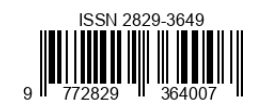Representation of The Impact Of Social Gap That Affects Moral Values In The Film "Parasite"
DOI:
https://doi.org/10.56910/literacy.v1i2.216Keywords:
Communication Media; Parasite Films; Moral Message;Social InequalityAbstract
The modern era is an era marked by the development of science and technology as well as socio-cultural developments that take place rapidly through various sources and media. Communication media is often used by the public in a positive learning world, for example as a means of delivering moral messages. There are many types of moral messages conveyed through communication media, one of which is through films. This study aims to determine the impact of social inequality and moral messages contained in the film 'Parasite'. The method used is qualitative and quantitative methods, namely through observation of dialogue data in films, expressions, and plot practices, action data in each scene, demands from each story session, and also audience comments. The results obtained from this parasitic film can criticize life in South Korea, especially the socio-economic gap between the rich and the poor. This film also contains many hidden meanings, such as the comparison of body odor as a social marker between rich and poor families, the help of insiders in the world of work, and the comparison of the meaning of rain for the rich as a blessing, for the poor it is a disaster.
References
Angerler, J. (2016). Images of God in Toba Batak storytelling. Wacana, Vol 17, No 2 (2016): Stories and storytelling in Indonesia I, 303–335. http://wacana.ui.ac.id/index.php/wjhi/article/view/444
Jeyifo, B. (2003). Wole Soyinka : politics, poetics, postcolonialism / Biodun Jeyifo. Cambridge : Cambridge University Press.
Padgett, D. K. (2016). Qualitative methods in social work research (Vol. 36). Sage publications.
Ramaswamy, V., & Gouillart, F. J. (2010). The power of co-creation: Build it with them to boost growth, productivity, and profits. Simon and Schuster.
Ratna, I. N. K. (2011). Antropologi Sastra: Mata Rantai Terakhir Analisis Ekstrinsik. Mabasan, 5(1), 287833.
Yilmaz, K. (2013). Comparison of quantitative and qualitative research traditions: Epistemological, theoretical, and methodological differences. European Journal of Education, 48(2), 311–325.







